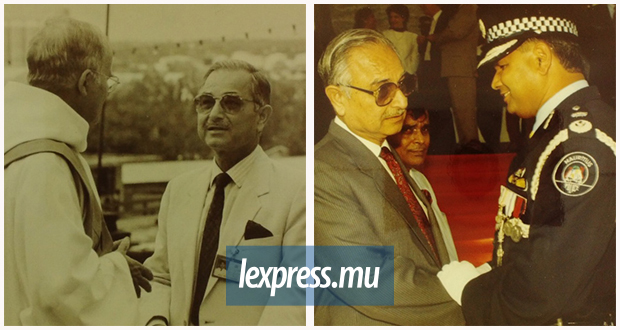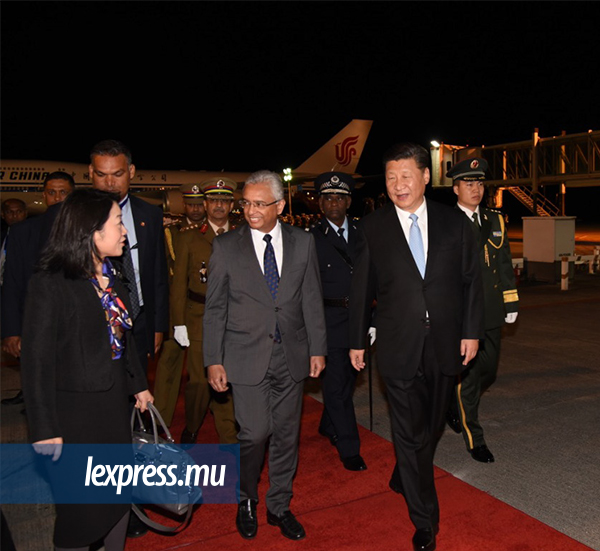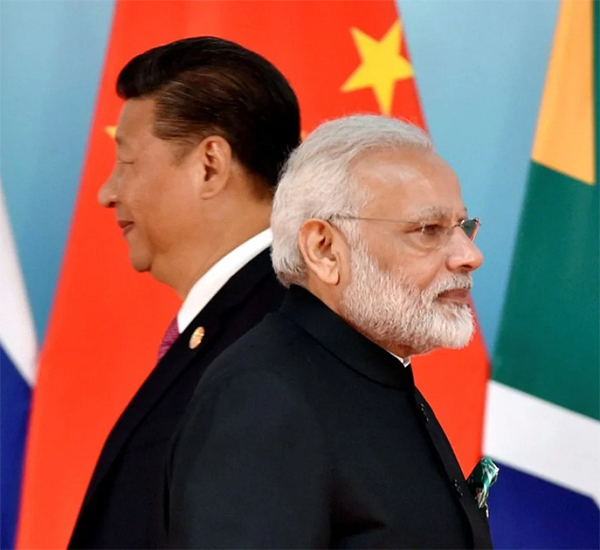Publicité
How Mauritius has ended up with Indian national security advisers…
Par
Partager cet article
How Mauritius has ended up with Indian national security advisers…

One unintended consequence that ex-CEO Sherry Singh’s allegations against the prime minister has thrown into the spotlight is the practice of Mauritius importing its national security advisers (NSA) from India. How unusual is this arrangement really, and is it something that is now proving to be a problem in the changing political landscape of the Indian Ocean?
1. The Indian NSAs
ONE of the unintended effects of ex-CEO of Mauritius Telecom Sherry Singh’s allegations about an Indian team allegedly installing spying equipment within Mauritius’ internet infrastructure is the manner in which it has thrown the spotlight on the unusual history of Mauritius importing its national security advisers from India. The allegations initially led to speculation that Kumaresan Llango, Mauritius’ national security adviser (NSA) since August 2021, was involved, which Singh later refuted. Followed by this Tuesday in parliament when the opposition MMM raised the question, including Llango’s record of alleged interference in Sri Lanka’s domestic politics until 2015. In response, Prime Minister (PM) Pravind Jugnauth accused the opposition parties of “systematic India-bashing” and of an “unacceptable attitude towards India”.
How a question over a formal employee of the defence and home affairs division of the Mauritian Prime Minister’s Office (PMO) become a question of bilateral relations between New Delhi and Port Louis only underscores how unusual this arrangement of importing NSAs looks. “This is a very unusual arrangement, where the national of another state is brought in to advise on the national security of another country,” says Ram Seegobin of Lalit, “there seems to be little logic in that. What all this does expose is the kind of security that Mauritian governments have wanted, rather than national security as such, and for that, they have all looked to India.” So the question to ask is, when and why did Mauritius start importing its NSAs from New Delhi?

2. Lal Dora and its aftermath
In 1974, when Mauritius and India signed a defence agreement, Mauritius swapped the UK for India as its main security guarantor. That agreement saw the security services of Mauritius deeply integrated with that of India, which provided training and hardware as well as officers to head the Mauritian Coast Guard and the police helicopter squadron. This situation changed dramatically in 1983: the MMM-PSM had smashed the Labour Party in a 60-0 victory in the 1982 elections. But a few months into the new government, things started falling apart. “The local political context just imploded as the MMM broke up,” explains Vijay Makhan, ex-Mauritius’ foreign secretary. The party was split along communal lines with the MMM headed by Paul Bérenger on one side, while a new party, the MSM, led by PM Sir Anerood Jugnauth emerged on the other.
Like the Labour Party government before it, Jugnauth started raising the spectre of an MMM power grab. “There were fears and speculation that the MMM might just hatch a coup d’état,” says Makhan, “so the MSM started approaching the Indians.” Jugnauth flew to New Delhi in February 1983 seeking the help of then-Indian PM Indira Gandhi, who reportedly reassured him that the Indian air force could reach Mauritius within five hours.
That year also saw the infamous ‘Operation Lal Dora’; where Indira Gandhi ordered the Indian army and navy to coordinate an amphibious landing in Mauritius’ capital Port Louis in the event of an MMM coup. This failed for a number of reasons: the Indian navy backed the plan after becoming inspired by the British military intervention in the Falklands’ war, while deputy army chief R.K Sinha was sceptical about the plan, given a disastrous 1971 attempt by the Indian army to organize an amphibious landing in Bangladesh’s Cox’s Bazaar that led to the drowning of several Gurkha troops. He was also worried that an armed intervention by New Delhi could spark a US reaction.
While the Indian army and navy bickered about the operation, the 54th battalion of the Indian army that was supposed to be the one coming to Port Louis, marched from Hyderabad to Mumbai without telling the Indian navy and attempted to barge into the Indian ship, the INS Mysore. While the troops languished in Mumbai waiting to come to Mauritius, the whole plan was dropped after somebody (suspected to be Sinha himself) leaked the whole plan to the US embassy.
Deepening of links
As the military card collapsed, New Delhi looked to utilizing its intelligence agency, RAW, instead. Indira Gandhi sent the head of RAW, N.F Suntook, to Port Louis, who along with then Indian High Commissioner Prem Singh (who backed Jugnauth over Bérenger) worked to cobble together an alliance under Jugnauth’s MSM to beat back the MMM threat. They succeeded and helped the MSM win the 1983 elections. This led to a deepening of links between the Indian and Mauritian governments. Following his election victory, Jugnauth asked for an Indian national security adviser and Major General J.N. Taimini, the Indian Army’s Chief Liaison Officer with RAW, was sent. Taimini stayed in the post for over a decade. For Mauritius, the decision to recruit Taimini came as part of a broader reversal by the MSM of the foreign and domestic policies that were being explored by the short-lived 1982 MMM-PSM regime.
The new foreign minister Gaëtan Duval declared that Mauritius was a “staunch ally of the West” as the government proceeded to cut links with Libya – then accused of backing the MMM – as well as downgrading links with the Soviet Union, leading to the recall of Soviet ambassador Nikolai Pankov. A ban on supplying labour to the US base on Diego Garcia was lifted and fraying relations with apartheid South Africa were repaired. This U-turn also applied to NSAs: the old Labour Party under Sir Seewoosagur Ramgoolam had hired British national John Rewcastle as its NSA until 1982 – Rewcastle left Mauritius on the eve of the announcement of the 1982 election results.
The new MMM-PSM government did not replace Rewcastle, leaving the post vacant. Taimini’s nomination in 1983 ended that policy. “From then onwards, we started having a much closer relationship with the Indians,” explains Makhan, “at one level it was an indication of the closeness of the two states and on the other it was also the fact that the Indians were the easiest door to knock; you could not go to the UK because of the Chagos issue; France was more interested in its former colonies on the African mainland and the US was content to be in Diego Garcia. The Indians were also eager about this given that in diplomacy, you only have permanent interests. The NSAs from India have been with us since then, some discreetly present, and some discreetly absent”.
The string of such advisers included Taimini, Ramesh Shumoogum and Tiru Govind. Bushan Nandy was a good example of the profile of typical NSAs sent from New Delhi, after having worked in India’s intelligence bureau and RAW, where he was active in Dhaka and Bangkok before briefly heading the Indo-Tibetan border police and then coming to Mauritius. But these NSAs also came to serve India’s foreign policy preoccupations. Take, for example, the 2008 entry of Gurinder Singh to Mauritius. His entry coincided with the establishment in November 2008 of an anti-terrorism unit within the Mauritian police. Gurinder Singh was also given the job by the then-Navin Ramgoolam government of heading the new unit which still exists, in addition to heading the NSS, which NSAs did. Others include Shantam Mukherji and, of course, current NSA K. Llango.

3. How unique is this relationship really?
The question now becomes how unique this arrangement really is. Within Mauritian political history, of course, there is precedent to turning to foreign NSAs such as Rewcastle until 1982. Seen in this way, turning to Indian NSAs seems to be little more than a further indication of the reality of India replacing the UK as the guarantor of Mauritius’ security.
Nor is that arrangement as unique within the Indian Ocean as critics of the practice make it appear. Like Mauritius, the Seychelles too has traditionally come to rely on Indian advisers to make up for domestic political insecurities. As far back as 1982, fearful of coup attempts orchestrated from South Africa, Seychelles’ President Albert René asked for a firm guarantee from Indira Gandhi that India would protect him. New Delhi reciprocated by providing Seychelles with military hardware, training for its armed forces and frequently visiting with their warships. But New Delhi did not formally take up the mantle of protector of the René regime until a series of coup attempts took place in 1986.
The first was a plot by René’s defence minister Ogilvy Berlouis, involving 30 foreign mercenaries and 350 Seychellois in June that year. The Indian prime minister – at the time Rajiv Gandhi – reacted by ordering an Indian navy ship the INS Vindhyagiri to stay in Seychelles for two weeks and conduct commando assault simulations to scare any would-be coup plotters. The Indian ship was backed by the Soviet Patrol boat, Zoroaster, that began patrolling to guard against the possibility of a rumoured British intervention to back the Berlouis coup.
Then in August 1986, while René was at a non-aligned meeting in Harare, Rajiv Gandhi heard of another coup plot underway in the Seychelles. He lent his plane – Air India 001 – to spirit René back to Seychelles, disguised in a sari, where he was hidden away by the Indian High Commissioner while the coup plotters within the Seychelles’ army were arrested or forced into exile in London. Another coup attempt in October was tried, involving an associate of former Seychelles’ President James Mancham and an Australian mafioso Peter Drummond, to try to attack a prison, free political prisoners and take control of Seychelles’ capital Victoria. That failed when Drummond was arrested for murder in Australia. As in Mauritius, these experiences led the way for Seychelles to rely for its security on Indian advisers; in this case, maritime security advisers at the President’s office traditionally supplied by the Indian navy. Mauritius importing a NSA does not seem so unique within the Indian Ocean.
But there is a significant difference between Mauritius and Seychelles: whereas in Mauritius the entry of Indian NSAs presaged an increasingly exclusive reliance on New Delhi to provide for Mauritius’ security; the presence of Indian advisers in Seychelles has not stopped Victoria from entering or exploring security arrangements with other states such as hosting a US drone base for P3 Orion and Reaper drone flights to and from Somalia and Eastern Africa, and offering to host the US Africa command in Victoria in 2009; getting patrol boats from the UAE or offering in 2011 to make Victoria port available to the Chinese navy for resupply during anti-piracy patrols; or rebuffing an Indian bid to build a military base on Assumption Island.

4. The changing landscape
The last two decades have seen a deepening of the India-Mauritius security relationship. Since 2003, the Indian navy has patrolled Mauritius’ exclusive economic zone; since 2009, New Delhi has been conducting hydrographic surveys in Mauritian waters and has installed a string of coastal radar systems along the Mauritian coast as well as its outlying islands to allow New Delhi to monitor shipping passing through them. Since 2006, India has also pushed for a surveillance facility on Agalega – Wikileaks cables quoted US diplomats stating that Agalega showed that it was “indicative of Mauritius’ willing subordination to India”.
In 2015, New Delhi got what it wanted. In addition, India has emerged as a major economic partner: since 1991, Mauritius’ offshore and banking sectors have benefited enormously from a tax treaty with India and a recent trade pact is seen as a potential shot in the arm for Mauritius’ struggling textile and sugar exports. But this arrangement of importing NSAs from India is also taking place in a changing geopolitical landscape within the Indian Ocean region that calls into question just how appropriate such an arrangement is anymore. “We are gradually getting into a situation where there just does not seem to be much difference between Mauritius and Indian definitions of national security,” argues Seeogin, “it’s all getting slightly murky.”
Take, for example, Mauritius’ claims on the Chagos: Port Louis claims the islands as its own, while New Delhi is now coming to rely on the US base on Diego Garcia as an essential prop for its own regional ambitions. “Where does that leave Mauritius diplomatically?” asks Seegobin. This question is being answered – to an extent – by a compromise as outlined by Makhan: “It’s not such a contradiction; for the Indians it’s a question of being able to access the facilities on the US base on Diego Garcia, while Mauritian governments have come forth to say that the US base can stay.” This, however, is the simplest of the foreign policy conundrums that the increasingly close security relationship between Port Louis and New Delhi seems to belie.
This is showed by Port Louis’ deepening engagement in an India-led regional architecture, most notably, the Colombo Security Conclave that Mauritius officially joined this year. A lot of the business at the conclave is handled at the level of the NSAs of its member-states. This raises a basic question: to what extent does a NSA handpicked by New Delhi represent Mauritius’ foreign policy at such forums? “It’s very difficult to explain the logic of sending ‘our national security adviser’ at such a forum propelled by India,” says Makhan. This is a question that’s becoming harder to ignore given the changing geopolitical landscape within the Indian Ocean.
“When the first national security adviser was sent from India, he was coming from a non-aligned, progressive power in the region and entering into such an arrangement seemed like a reasonable way of moving away from older powers such as the UK and France,” says Seegobin, “but India today is a close ally of the US and is very much a part of Washington’s China-containment strategy.” Like India, China has managed to become a major economic partner for Mauritius, particularly since 2007 when it bankrolled a number of infrastructure projects in Mauritius and recently also signed a free trade pact. For this reason, although India has been quite forthright about its growing competition with Beijing within the Indian Ocean, Mauritius has been keen to avoid the perception that its deepening security links with India are aimed against China. At least formally, Port Louis wants to be seen as a friend both of New Delhi and Beijing.
So, what happens when New Delhi pushes for a more muscular approach against China? And more importantly, what role would an Indian-supplied NSA play? “That is the question; what advice would Mauritius’ national security adviser give? Would the Mauritian government turn to him for advice on how to deal with China? No one seems to have answer for that,” insists Makhan, “this is a complicated situation that would seem to demand Mauritius starting to have its own national security advisers craft our own policies.” For Seegobin, “if Mauritius is going to rush into this kind of China-containment strategy, it will make it very hard to deal with the Chinese; in going the way it is, I don’t think the Mauritian government really realizes what it is doing.”
Publicité
Publicité
Les plus récents






